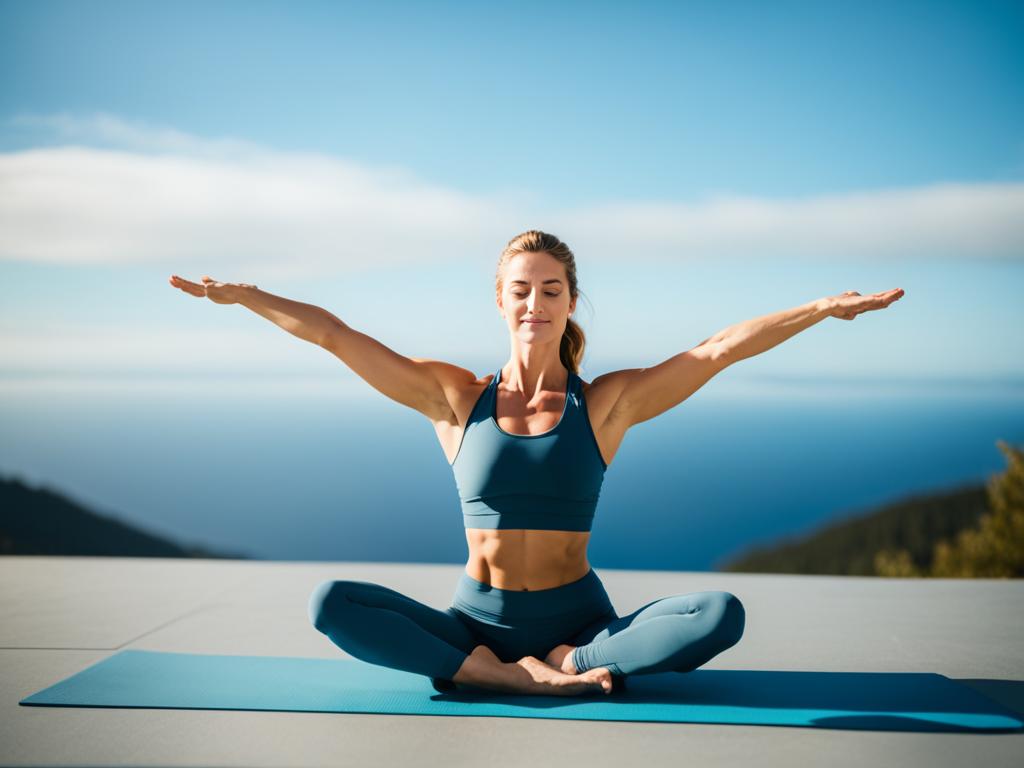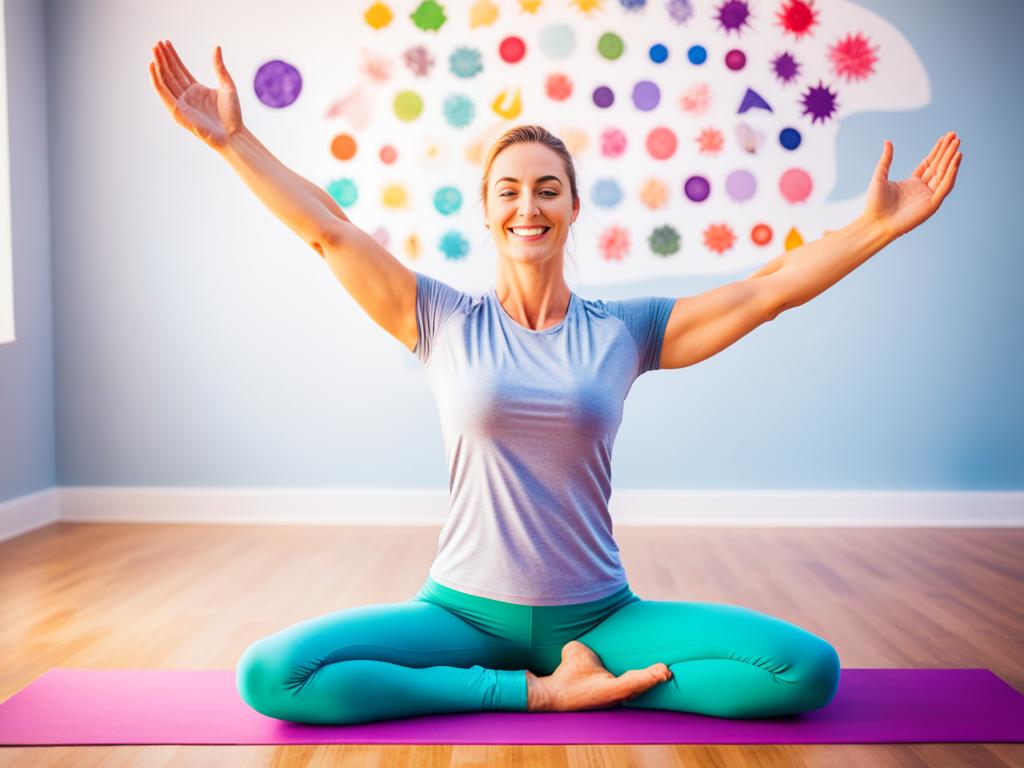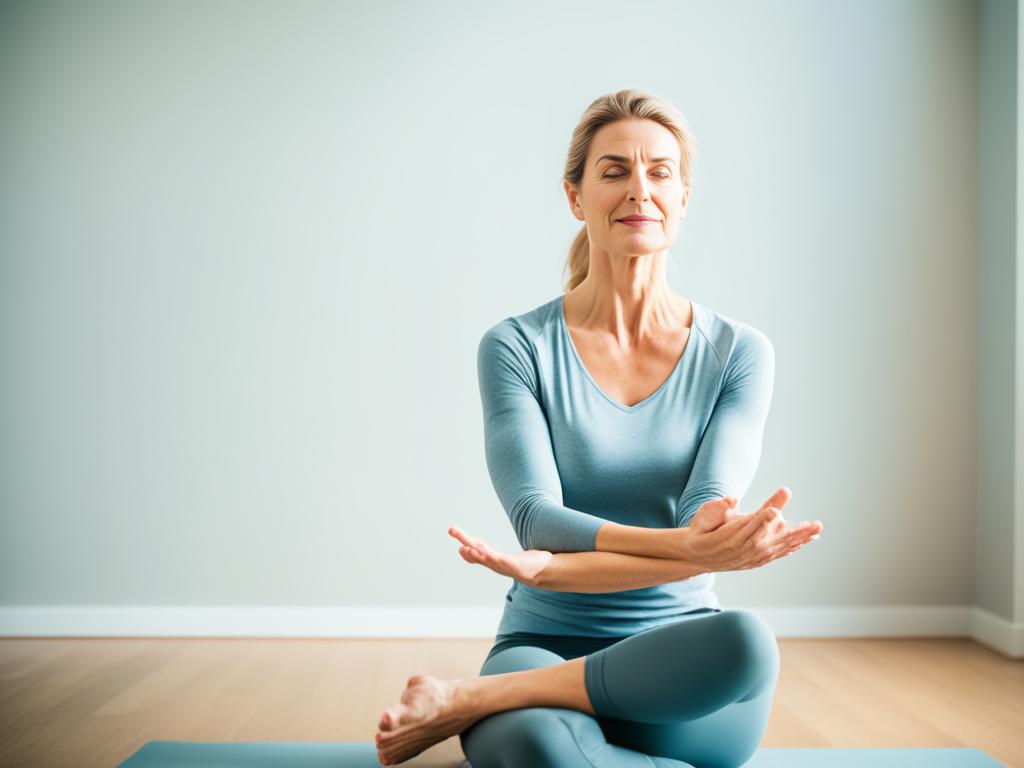Do you want to become more flexible and have a body that moves with ease? Yoga is your perfect match. It brings together mindful movements and breathing techniques. This mix leads to impressive changes in your body.
Yoga is a complete way to work on being more flexible. It focuses on your whole being – not just your body but also your mind and breath. Regular yoga sessions will surprise you with what your body can do.
But, how does yoga actually make you more flexible? What kinds of yoga moves and exercises help your muscles and joints loosen up?
This article is all about yoga and how it boosts your flexibility. Whether you want to avoid getting hurt, help with physical therapy, or just be more flexible overall, we have you covered. Ready to learn the secrets of yoga and flexibility?
Understanding the Importance of Flexibility Training
Flexibility training should be part of everyone’s fitness plan. It helps improve motion in your joints and keeps you safe from injuries. This is important whether you’re an athlete, someone who loves working out, or just aim to be healthy.
Stretching keeps your muscles and tissues flexible. This allows for easier and wider movement. It also makes your muscles less tight and helps you stand up straight. By doing this, you can avoid the pain that comes from muscle issues.
Better flexibility means fewer chances of getting hurt. It makes your joints stronger for activities. This cuts down the risks of common injuries like sprains. Plus, being more flexible boosts how well your body works overall, improving sports and everyday tasks.
“Flexibility training is key for everyone, not just athletes. It keeps you from getting muscle problems and helps you move better. It’s like making sure you’ll be well for a long time.”
There are a few types of stretches that can make you more flexible. Static stretching is about holding a pose to stretch slowly. Dynamic stretching gets your body moving a lot to prepare for harder physical stuff. PNF stretching mixes contracting and relaxing muscles to stretch them more effectively.
To get the most out of being flexible, vary your stretches. Hit all your main muscle groups so you’re flexible everywhere. Classes like yoga or Pilates are perfect for this. They offer good routines and teach you new ways to stretch.
The Power of Stretching Exercises
Stretching can change your body and make it better. It helps your joints move more freely, prevents injuries, and boosts how well you perform physically. It’s a must for anyone wanting to stay fit and active.

The Benefits of Yoga for Flexibility
Yoga is great for improving flexibility. It does more than help you touch your toes. It teaches you to move with focus and control your breath. This, in turn, makes you more aware of your body and boosts flexibility.
Yoga is special because it’s about moving mindfully. Other exercises might push you hard. But in yoga, it’s about listening to your body and moving gently. This mindful practice deepens the link between your mind and body. Thus, it increases your flexibility as time goes on.
Yoga also includes various stretches for all muscles. This helps lengthen muscles and boosts how much your joints can move. Over time, regular yoga makes moving gracefully easier, both in yoga class and in life.
“Yoga is the journey of the self, through the self, to the self.” – Bhagavad Gita
Yoga isn’t just about flexibility. It can help a lot with healing from injuries, too. Many therapists add yoga to recovery plans because it can make muscles stronger and more limber. It also boosts balance and body awareness. Doing yoga the right way, with a good teacher, can help you recover safely and get flexible again.
Yoga: A Holistic Approach to Flexibility
Yoga’s approach to flexibility is complete. It’s not only about stretching or making muscles strong. It combines stretching with careful movement, controlling your breath, and being aware of your body. This mix helps your body and mind feel better.
Add yoga to your exercise routine for better flexibility. You’ll be able to move more freely and your body will thank you. On top of that, everyone, whether new to yoga or experienced, can gain from its flexibility benefits.

Incorporating Yoga into Your Routine
Adding yoga to your routine can boost your flexibility. It mixes mindful movement, breath control, and stretches. These elements help you meet your flexibility goals. Here are some tips to fit yoga into your day.
Finding a Style That Suits You
Different yoga types focus on various things. To keep doing yoga, find what you like best. You may enjoy calm Hatha yoga or active Vinyasa flow. Trying out different styles helps you find the best fit.
“Yoga is not about touching your toes. It’s about what you learn on the way down.” – Jigar Gor
Finding a favorite yoga style helps you stay committed. This can boost your flexibility with time.
Online Classes and Yoga Studios
Today, you can find yoga classes online easily. These classes suit everyone, from newbies to pros. You can learn from home, with various instructors and styles to pick from.
Or, if you prefer in-person coaching and a studio’s atmosphere, try local studios. They have classes for all levels and offer a supportive space.
Both online and in-person sessions are great for your flexibility. They make it easy to keep up with yoga regularly.
Making Yoga a Lifestyle
Regular yoga is about consistency. Plan to do yoga two or three times a week and increase gradually. This way, you’ll boost your flexibility and feel better overall.
Don’t limit yoga to just classes. Try to use yoga’s principles every day. This can be simple breathing exercises or a few gentle yoga poses. These mini practices can improve your flexibility over time.
Yoga’s not just about stretching; it’s a journey of growth. Adding yoga to your days can improve flexibility and connect your mind and body better.
Yoga Poses for Flexibility
Improving your flexibility with yoga is very effective. It’s great for reaching different muscles and making them stretch longer. Poses work for everyone, no matter your level of experience.
Include these yoga poses in your routine to enhance flexibility and movement:
1. Downward Dog
Downward Dog is a well-known pose that stretches your whole body. It works your hamstrings, calves, shoulders, and upper back. Start on all fours, with your wrists under shoulders and knees under hips. Then, push your hips up. Slowly straighten your legs, and push your heels down.
2. Standing Forward Fold
This pose gives a deep stretch to your hamstrings and calves. Stand with feet hip-width apart and fold forward at your hips. Bend your knees if needed to touch the ground. Let your upper body relax. You can use blocks for support.
3. Pigeon Pose
Pigeon Pose is good for your hip flexors, glutes, and lower back. Start in a high plank. Bring your right knee forward, placing it behind your right wrist. Slide your left leg back. Slowly lower yourself, resting on your forearms. Repeat on the other side.
4. Cobra Pose
Cobra Pose stretches your chest, shoulders, and abs. Lie down with your palms next to your shoulders. Press through your hands to lift your chest. Keep your lower body down. Remember to avoid over-straining.

These poses are just a start for increasing your flexibility. Listen to your body and progress at your own speed. With regular practice and patience, you can make your body more flexible. This will also benefit your mind with the peace that yoga brings.
Preventing Injuries through Yoga
Adding yoga to your daily routine is a smart way to stay safe from injuries. It teaches you to move mindfully and be aware of your body. This leads to more stable movement and lowers the chance of getting hurt during physical tasks. Yoga makes your body more flexible and strengthens the muscles, tendons, and ligaments. These are the building blocks to moving safely and without injuries.
Yoga teaches us to pay attention to our body’s signals and not go past what’s safe. This approach stops us from stretching too far or straining, which cuts down the risk of muscle and joint injuries. Also, breathing techniques in yoga help you stay focused. This means you are less likely to get hurt because you’re not paying attention.
“The practice of yoga not only helps prevent physical injuries but also fosters a deep connection between the mind and body. This mind-body connection allows practitioners to become more attuned to their movements, making them aware of any potential imbalances or weaknesses that could lead to injury.”
There are specific yoga poses that are great for stopping injuries. These poses make your core stronger, like Boat Pose and Plank Pose, which keeps your spine strong and stable. Poses like Pigeon Pose and Butterfly Pose help with hip flexibility. This means you’re less likely to hurt your lower back or knees. You can focus on these poses to strengthen any weak spots you might have.
Yoga is also useful if you’re already injured. Practices like Yin Yoga and Yoga Therapy can help with pain and swelling. They also help move better after an injury. These types of yoga aren’t just good for the body. They also relax the mind and help with healing emotionally.
The Importance of Mindful Movement
Mindful movement is the secret to not getting injured in yoga. It means paying attention to how your body moves, positioning it right, and moving purposefully. This lowers the risk of muscle strains and other injuries. Being mindful helps us connect more to our bodies. This lets us react quickly if something doesn’t feel right, protecting ourselves.
Yoga helps us know more about our body. This means we can spot and fix problems before they get serious. It’s like a guard in stopping injuries before they even start. This kind of care makes our body stronger and less likely to get hurt.
Yoga can become a way of life, even outside the studio. You can use what you learn in yoga in any other sport or activity. This makes you better at whatever you do and keeps you safe from getting hurt.
| Benefits of Yoga for Injury Prevention | Yoga Poses for Injury Prevention |
|---|---|
| Enhances stability and balance | Boat Pose (Navasana) |
| Improves flexibility and range of motion | Pigeon Pose (Kapotasana) |
| Strengthens the core muscles | Plank Pose (Kumbhakasana) |
| Reduces stress and tension | Butterfly Pose (Baddha Konasana) |
Incorporating yoga into your life is a great way to protect yourself from injuries. It teaches you to move carefully, get more flexible, and make the body stronger. With this, you lessen the chance of getting hurt and move more gracefully. Start your yoga journey to see how it can make you physically stronger and improve your life in many ways.
Conclusion
In conclusion, yoga is a great way to boost flexibility. It mixes moving carefully and controlling your breath, with lots of stretching and mobility work. This helps your joints move better, stretches your muscles, and makes you more in tune with your body.
If you want to avoid getting hurt, or you’re in physical therapy, yoga is an excellent choice. It’s all about a complete path to reach your goals. Plus, it’s fun to do!
Begin your yoga trip right now and see the changes. Yoga’s focus on doing it often means you get better slowly in a lasting way. This helps you move your body more and stay away from getting hurt. Besides, yoga makes your body and mind feel great.
So, don’t delay. Try yoga and see how it makes you more flexible and healthy. Stick to it, do it often, and see the great stuff it does for you. No matter if you’re starting or you’ve been doing it for a while, yoga can work for you. It’s a start to a more bendy, safer life with yoga!




